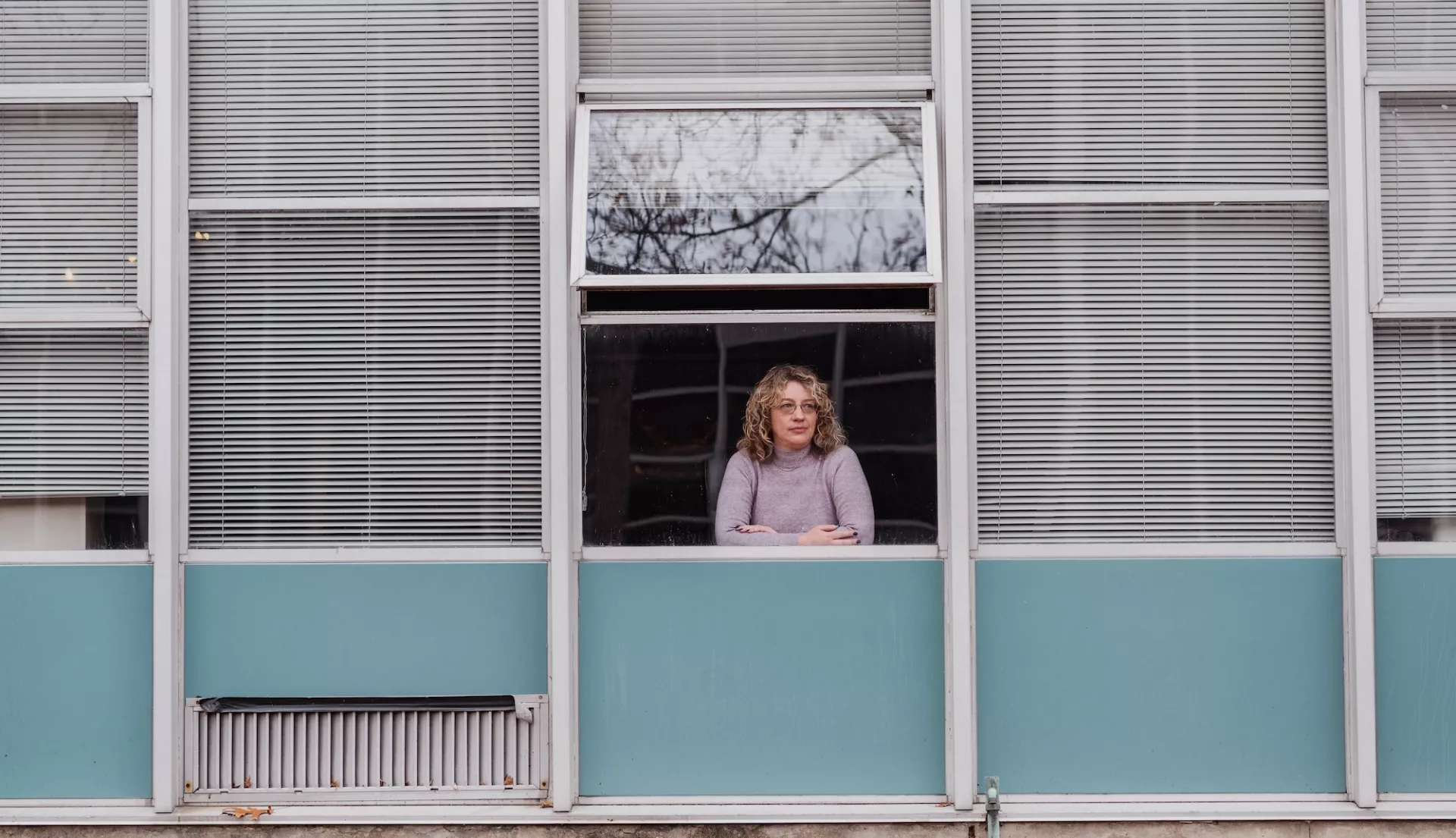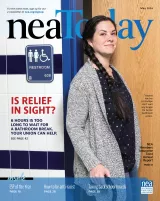Key Takeaways
- Unlike other groups of professionals, teachers frequently deprive themselves of drinking water because they have no bathroom access for hours on end.
- Bladders work like elastic waistband pants. If you streee-ee-etch them over and over again, they lose shape and function.
- Solutions are possible! Some local unions have bargained for contract language that guarantees bathroom breaks or self-directed time. Others have won state legislation.
63%
20%
Virginia teacher Liz Boddye might be wearing incontinence underwear today. “If I’m sick or coughing, there’s no hope for me. I’m going to be frank about that,” she says. Boddye is only 42. But she’s also a mother and a teacher—and these factors don’t work in her favor when it comes to bladder issues and bathroom access.
How hard is it for most classroom educators to use the bathroom when they need to? Too hard, educators say. Despite federal requirements that guarantee U.S. workers the right to use an employer-provided toilet when they need to, the reality is that many teachers regularly stretch their bladders for hours.
“That’s so cute when you say federally protected rights. It’s also in county code!” says Boddye, who works in a self-contained classroom for students with emotional disabilities in Prince William County, Virginia. She can’t just leave her kids, not even for a duty-free lunch.
“Today, for example, I didn’t get lunch—and I didn’t go to the bathroom for like three hours after I had to go,” she says.
Holding in a half-liter of pee through reading, math, and science, or back-to-back-to-back block periods, can have lifelong consequences.
There’s a reason that urologists call it “teacher bladder.” Is there another profession that requires a master’s degree, but also demands you put on Depends?
But solutions are possible, union leaders say. Working through your building reps, sitting down at the bargaining table, and taking the issue to state lawmakers are all viable strategies to protect your right to toilet access.
‘I Hope I Don't Drip’
Incontinence supplies are not the solution, says South Carolina professor Jonathan Coker. Relaxing teacher dress codes so that educators can wear easy-to-slide-off yoga pants is another nonanswer, he says.
For his 2022 research on teachers’ bathroom breaks, Coker talked to a Georgia high school teacher who miscarried because of chronic dehydration. She avoided drinking because she didn’t have time for the toilet.
“We have six minutes between bells. We’re supposed to be in the hallway for those whole six minutes,” she told Coker.
A second teacher told him she packs lunch with an eye to what might cause a bowel movement. (She doesn’t have time in her workday for bowel movements.)
A Maine educator recounted how menstrual blood once dripped down her leg, in her classroom, because she hadn’t had time to change her tampon. “I kept thinking, I hope I don’t drip on the floor,” she told Coker. “The stories are just so harrowing,” he says. “Hearing people describe in graphic detail their bodies being hurt, every day. I wasn’t expecting to be addressing so much violence.”
Quote byEmily M., via Facebook
Coker, who did this research as part of his doctoral dissertation, notes the problem is often overlooked or dismissed, probably because it mostly affects women. To him, the answer is funding. “The question is, who is going to supervise these kids if I run out of the room?” he says. “We need to put more pressure on school districts, on governments, to provide more funding so that we can have more teachers’ aides. Teachers with aides don’t have bathroom problems,” he says.
Your Union Has Answers
Teachers at six charter schools in Oakland, Calif., also don’t have bathroom problems. Their contract, which they bargained in 2020, guarantees them a lavatory within 400 feet of their classrooms. Where that’s not possible, they go no more than two consecutive hours of work without a bathroom break.

“There aren’t many professions that expect professionals to do their work without bathroom breaks,” says Liv Perez, co-president of the Oakland union, the Coalition of Educators for Change. Since ratifying their first contract in 2020, Perez says coalition members have not experienced any delays in getting the breaks they need.
“I’m really proud that we thought of this [contract language], but I’m also sad it has to be in there, because it speaks to a larger systemic issue,” she adds.
Similarly, in Orange County, Florida, contract language added in 2019 guarantees teachers the right to call the office at any time of day and get classroom coverage without delay.
Before negotiations, union leaders surveyed members and found that 47 percent were supervising students for three or more continuous hours. Two-thirds said they avoided drinking water and 20 percent had sought medical care for bladder-related issues.
Most of All, Speak Up!
Bargaining for more planning time can also help create opportunities for teachers to go to the bathroom.
After teachers went on strike in Portland, Ore., in 2023, their guaranteed planning time jumped from 320 minutes per week to 410. In Andover, Mass., teachers recently won 15 minutes a day of unstructured time through bargaining.
In places where collective bargaining rights are curtailed, go to your statehouse. In 2022, South Carolina elementary and special education teachers persuaded lawmakers to guarantee at least 30 minutes a day of duty-free time for the educators. At least 23 other states have similar laws, according to Education Week.
Quote bySusan D., via Facebook
Most of all, speak up, urges Sarah Polda, a Washington high school teacher who has experienced bladder issues.
“My generation suffered in silence,” says Polda, who is 63. “Call the office and make someone show up. Have building [or association] reps make this a part of their agenda when meeting with administration.”
When she was a building representative, Polda worked on expanding the number of administrators and employees who could watch a class for five minutes. The more people, the better.
The “Happy” Bladder
Urologists do indeed call it ‘teacher bladder,’ confirms Dr. Lori Lerner, a Massachusetts urologist. Imagine your bladder works like a pair of elastic waistband pants, she says. Stretch them, and stre-e-eetch them, and you get saggy pants, right?
“We see people who hold [pee] in to such a degree that it will take several contractions for them to empty. In the worst scenario, those people will lose bladder function. They’ve stretched the muscle to such a degree that it can’t contract,” she warns.

While plenty of men have incontinence, it’s far more common among women. Shorter urethras and post-pregnancy loss of muscle tone in the urethra can lead to stress incontinence, which— after giving birth five times—is Boddye’s issue.
A “happy bladder” is hydrated and emptied regularly, Lerner says. Coffee is an irritant, but water is great, she adds.
Retired Maryland teacher Kenneth Haines did hydrate, he says—at 4:30 a.m., when he woke up to grade papers, drink water, and pee. But frequently, 12 hours would pass before he saw a toilet again. His high school campus was huge— the few staff bathrooms were far apart—and he simply didn’t have time to go.
After 30 years of “holding it in,” Haines now needs 24-hour access to a toilet (per his urologist), and it takes him three to five minutes to empty his bladder. He’d love to be teaching today, but these issues make it impossible. It’s a poor reason to lose a successful educator, he grimly points out.
Retired Michigan teacher Karen Eglinton has also been in the care of a urologist for 30 years. “When I started, in 1975, we didn’t usually get any breaks until lunch,” she says. And even then, it wasn’t guaranteed. “I had a colleague who got desperate once and went to the kids’ bathroom. She had a kid look over the top of the stall and say, ‘Hi, missus!’”
Today, Eglinton has stress incontinence, frequent bladder infections, and is unable to urinate without the help of gravity. “When you’re young, you don’t think it’s an important thing,” she sighs







